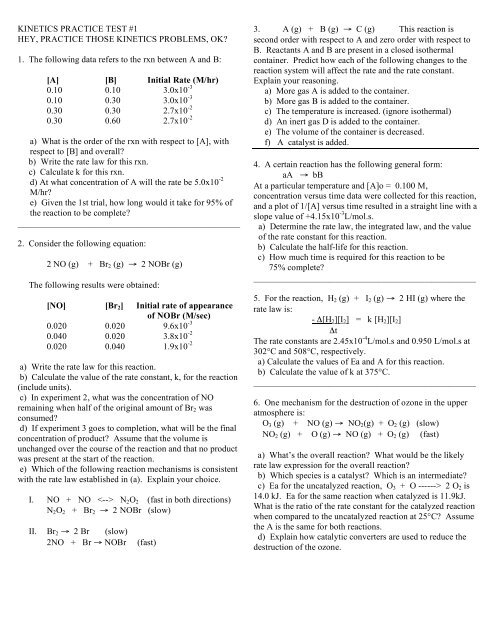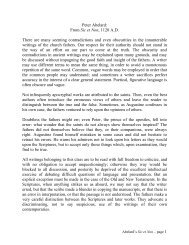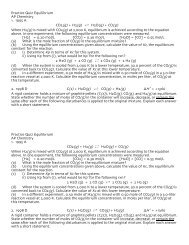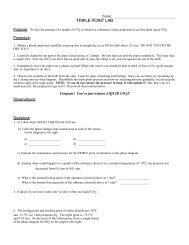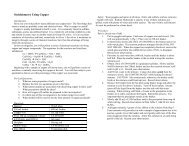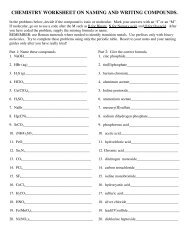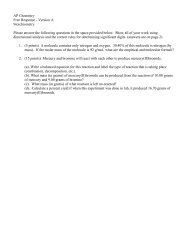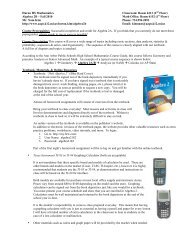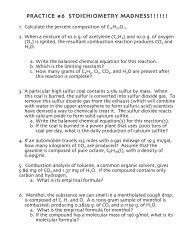KINETICS PRACTICE TEST
KINETICS PRACTICE TEST
KINETICS PRACTICE TEST
You also want an ePaper? Increase the reach of your titles
YUMPU automatically turns print PDFs into web optimized ePapers that Google loves.
<strong>KINETICS</strong> <strong>PRACTICE</strong> <strong>TEST</strong> #1<br />
HEY, <strong>PRACTICE</strong> THOSE <strong>KINETICS</strong> PROBLEMS, OK?<br />
1. The following data refers to the rxn between A and B:<br />
[A] [B] Initial Rate (M/hr)<br />
0.10 0.10 3.0x10 -3<br />
0.10 0.30 3.0x10 -3<br />
0.30 0.30 2.7x10 -2<br />
0.30 0.60 2.7x10 -2<br />
a) What is the order of the rxn with respect to [A], with<br />
respect to [B] and overall?<br />
b) Write the rate law for this rxn.<br />
c) Calculate k for this rxn.<br />
d) At what concentration of A will the rate be 5.0x10 -2<br />
M/hr?<br />
e) Given the 1st trial, how long would it take for 95% of<br />
the reaction to be complete?<br />
__________________________________________________<br />
2. Consider the following equation:<br />
2 NO (g) + Br 2 (g) → 2 NOBr (g)<br />
The following results were obtained:<br />
[NO] [Br 2 ] Initial rate of appearance<br />
of NOBr (M/sec)<br />
0.020 0.020 9.6x10 -3<br />
0.040 0.020 3.8x10 -2<br />
0.020 0.040 1.9x10 -2<br />
a) Write the rate law for this reaction.<br />
b) Calculate the value of the rate constant, k, for the reaction<br />
(include units).<br />
c) In experiment 2, what was the concentration of NO<br />
remaining when half of the original amount of Br 2 was<br />
consumed?<br />
d) If experiment 3 goes to completion, what will be the final<br />
concentration of product? Assume that the volume is<br />
unchanged over the course of the reaction and that no product<br />
was present at the start of the reaction.<br />
e) Which of the following reaction mechanisms is consistent<br />
with the rate law established in (a). Explain your choice.<br />
I. NO + NO N 2 O 2 (fast in both directions)<br />
N 2 O 2 + Br 2 → 2 NOBr (slow)<br />
II. Br 2 → 2 Br (slow)<br />
2NO + Br → NOBr<br />
(fast)<br />
3. A (g) + B (g) → C (g) This reaction is<br />
second order with respect to A and zero order with respect to<br />
B. Reactants A and B are present in a closed isothermal<br />
container. Predict how each of the following changes to the<br />
reaction system will affect the rate and the rate constant.<br />
Explain your reasoning.<br />
a) More gas A is added to the container.<br />
b) More gas B is added to the container.<br />
c) The temperature is increased. (ignore isothermal)<br />
d) An inert gas D is added to the container.<br />
e) The volume of the container is decreased.<br />
f) A catalyst is added.<br />
4. A certain reaction has the following general form:<br />
aA → bB<br />
At a particular temperature and [A]o = 0.100 M,<br />
concentration versus time data were collected for this reaction,<br />
and a plot of 1/[A] versus time resulted in a straight line with a<br />
slope value of +4.15x10 -3 L/mol.s.<br />
a) Determine the rate law, the integrated law, and the value<br />
of the rate constant for this reaction.<br />
b) Calculate the half-life for this reaction.<br />
c) How much time is required for this reaction to be<br />
75% complete?<br />
__________________________________________________<br />
5. For the reaction, H 2 (g) + I 2 (g) → 2 HI (g) where the<br />
rate law is:<br />
- Δ[H 2 ][I 2 ] = k [H 2 ][I 2 ]<br />
Δt<br />
The rate constants are 2.45x10 -4 L/mol.s and 0.950 L/mol.s at<br />
302°C and 508°C, respectively.<br />
a) Calculate the values of Ea and A for this reaction.<br />
b) Calculate the value of k at 375°C.<br />
__________________________________________________<br />
6. One mechanism for the destruction of ozone in the upper<br />
atmosphere is:<br />
O 3 (g) + NO (g) → NO 2 (g) + O 2 (g) (slow)<br />
NO 2 (g) + O (g) → NO (g) + O 2 (g) (fast)<br />
a) What’s the overall reaction? What would be the likely<br />
rate law expression for the overall reaction?<br />
b) Which species is a catalyst? Which is an intermediate?<br />
c) Ea for the uncatalyzed reaction, O 3 + O ------> 2 O 2 is<br />
14.0 kJ. Ea for the same reaction when catalyzed is 11.9kJ.<br />
What is the ratio of the rate constant for the catalyzed reaction<br />
when compared to the uncatalyzed reaction at 25°C? Assume<br />
the A is the same for both reactions.<br />
d) Explain how catalytic converters are used to reduce the<br />
destruction of the ozone.
ANSWERS TO THE <strong>PRACTICE</strong> <strong>TEST</strong>:<br />
1.<br />
A) B is zero order, A is second order.<br />
B) rate = k[A] 2 [B] 0 OR rate = k[A] 2<br />
C) k = rate = 3.0 x 10 -3 M/hr = 0.30<br />
[A] 2 (0.10M) 2 Mhr<br />
D) rate = k[A] 2 rate = [A] 2 5.0 x 10 -2 M/hr<br />
k 0.30 M -1 hr -1<br />
= 0.41 M<br />
E) 1/[A] t - 1/[A] 0 = 1/[0.005] - 1/[.10]<br />
k 0.30 M -1 hr -1<br />
200/M - 10/M = 630 hr<br />
0.30 M -1 hr -1<br />
2.<br />
A) rate = k [NO] 2 [Br] B) k = __rate__<br />
[NO] 2 [Br]<br />
9.6 x 10 -3 M/sec = 1200<br />
(.02M) 2 (.02M) M 2 sec<br />
C) 2 NO (g) + Br 2 (g) → 2 NOBr (g)<br />
NO reacts with Br 2 in a 2:1 ratio. If Br 2 is half gone then<br />
0.010 M reacts. If 0.010 M Br 2 reacts, then 2X that of NO<br />
reacts (0.01 X 2 = 0.02 M NO lost). 0.040M – 0.02M = 0.02<br />
M NO remains.<br />
D) When looking at the reagents, you can see that the NO is<br />
the limiting reagent in trial 3. If you assume that the total<br />
volume of the reaction vessel is 1.000L then as 0.020 M of<br />
NO reacts, 0.020 M of the product, NOBr forms (coefficients).<br />
E) Trial one is the correct mechanism. Remember, the sum of<br />
the reactions needs to sum to the overall chemical equation<br />
AND the slow step’s rate law (exponents are coefficients –<br />
they don’t need to be experimentally determined) needs to<br />
match the overall rate law. Elementary step 2 has summation<br />
issues. You may think that E-step 1 does not work but<br />
remember:<br />
Anytime reversible arrows are used and the forward and<br />
reverse rates are equally fast, the reactants can be substituted<br />
for the products and vice versa. Badabingbadaboom.<br />
3) rate = k[A] 2 [B] 0 or rate = k[A] 2<br />
A) more reactants ∝ [ ] = rate ↑, but k ≠ ∆<br />
B) since B is zero order, the ∆ [B] ≠ ∆ rate, k ≠ ∆<br />
C) k = Ae -Ea/RT as T↑ ∝ k↑. If k↑, rate ↑.<br />
D) No ∆ in rate or k.<br />
E) ↓Vol ∝ ↑ [ A ] ∝ ↑ rate, k ≠ ∆<br />
F) k = Ae- Ea/RT as Ea↓ (using catalyst) ∝ k↑. If k↑, rate ↑.<br />
4.<br />
A) rate = k[A] 2 , 1/[A] t - 1/[A] 0 k = duh!<br />
k<br />
B) t 1/2 = 1/[A] 0 k<br />
1/0.100M (4.15 x 10 -3 L/molsec) = 2,410 seconds<br />
C) 1/[A] t - 1/[A] 0 = 1/[0.0250] - 1/[.100]<br />
k<br />
4.15 x 10 -3 L/molsec<br />
= 7,230 seconds<br />
5. natural log it!<br />
A) k = Ae -Ea/RT lnk = -Ea/R(1/T) + lnA<br />
So . . .lnk 1 = -Ea/R(1/T 1 ) + lnA and . . . .<br />
lnk 2 = -Ea/R(1/T 2 ) + lnA so . . .<br />
lnk 1 - lnk 2 = (-Ea/RT 1 + lnA) - (-Ea/RT 2 + lnA)<br />
rearrange: ln(k1/k2) = Ea/R(1/T 2 – 1/T 1 )<br />
B) Ea = 150kJ (using rearranged eq ↑)<br />
A = 1.02 x 10 10 (use Arhenius Eq. Insert k for 302°C and<br />
insert Ea to solve)<br />
k (@ 375°C) = 0.00826/Msec (use Arhenius Eq)<br />
6.<br />
A) O 3 + O → 2 O 2 , rate = k[O 3 ][NO]<br />
B) NO is acting as a catalyst.<br />
NO 2 is the intermediate.<br />
C) ratio of _catalyzed_ = _k cat__ = Ae -Ea(cat)/RT<br />
uncatalyzed k uncat Ae -Ea(uncat)/RT<br />
Since the chemicals used do not ∆, A (frequency factor) does<br />
not ∆.<br />
k cat__ = e -11,900J/8.314J/molK(298K) = e -4.80 = 0.00823 = 2.33<br />
k uncat e -14,000J/8.314J/molK(298K) e -5.65 0.00352 1.00<br />
In other words, the catalyzed reaction takes place 2.33 X faster<br />
than the uncatalyzed reaction.<br />
D) As you can see in the equations above, NO serves as a<br />
catalyst in the decomposition of O 3 . When gasoline is burned<br />
in cars, the O 2 used comes from the air. The diatomic nitrogen<br />
in the air combines with the O 2 in the engine (that is incredibly<br />
hot) and nitrogen oxides form - some of which are NO. By<br />
using a heterogeneous catalytic converter in a car. The<br />
catalyst will hold the NO on its active sites allowing for NO to<br />
react in a complex mechanism, which results in N 2 and O 2 as<br />
products. By using a catalytic converter, the NO is not<br />
available to destroy the ozone layer which protects us from<br />
harmful UV radiation.


